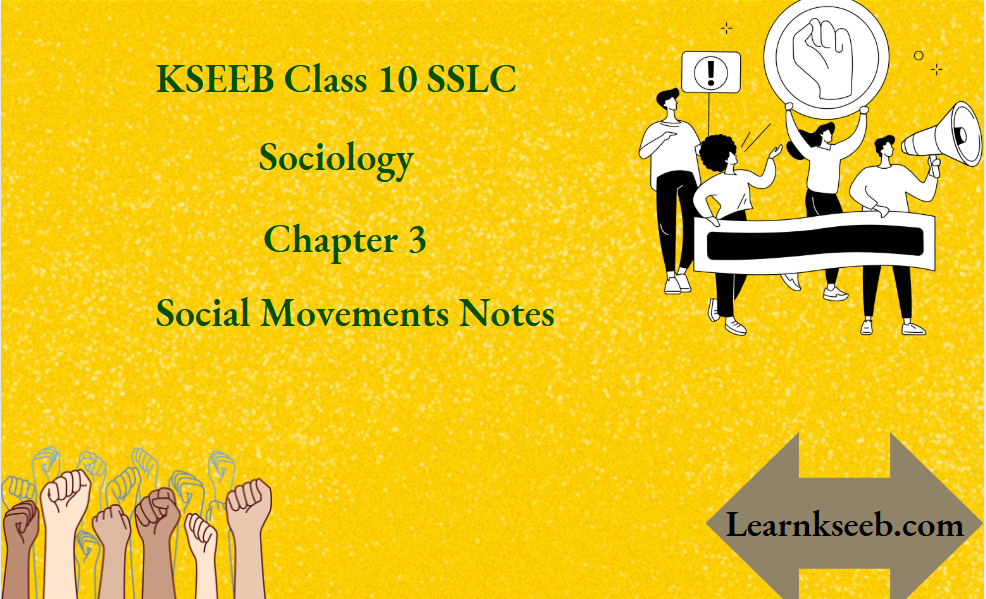KSEEB Class 10 SSLC Sociology Chapter 3 Social Movements Mobs And Riots
- Man is a social animal, and hence always lives in groups, communities societies.
- Collective behaviour is an integral part of our social life.
- The thoughts, feelings and behaviour of a large number of disorganizedpeople coming together accidentally constitute collective behaviour.
- Human behaviour coming under the scope of collective behaviour includes mobs, rumours, propaganda, public opinion, revolution, social movements,etc.
- When collective behaviour is organized and directed towards a specific goal and aims to bring about social change,it is called a movement. Environmental movements can be such an example.
Mob: An assembly of people around a common interest without any expectation or planning is called a mob.
KSEEB Class 10 SSLC Sociology Chapter 3 notes
Riots: Riots are another type of mob behaviour. Violent and destructive nature of mob behaviour is called a riot.
Environment Movement: The pollution of soil, air, water and biosphere with toxins and chemicals is called environmental pollution.
- Developed countries are destroying the environment for the purpose of their luxurious life.
- In addition, the unbridled growth of cities, proliferation of industries, technological progress, expansion of thetransport system, etc., are destroying the forests and polluting the environment.
- Many intellectuals, environmentalists and others have expressed their agitations about the environmental pollution.
- A few such important agitations against environmental pollution are Chipko Movement, Appiko Movement,Narmada Movement, Silent Valley Movement, and Movement against MRPL and Agitation against Kaiga.
- Chipko Movement
- Place – Tehri Garhwal District of Uttarakhand.
Took place in 1973 under the leadership of Shri Sunder Lal Bahuguna and Chandiprasad Bhatt.

As a result, the permission given to chop down the trees was withdrawn.
Social Movements SSLC Sociology notes
- Appiko Movement,
Place – Salyani village in Uttara Kannada district of Karnataka.
Took place in 1983, by the protest of the farmers.
They wanted to stop the smuggling of timber and develop awareness among the common people about theimportance of the environment. - Narmada Movement
Place – Sardar Sarovar Dam in Gujarat.
Took place in 1973 under the leadership of Medha Patkar and Baba Amte.
The Supreme Court’s decision is still pending, seeking stoppage of construction of the Sardar Sarovar Dam. - Silent Valley Movement
Place-Palghat Taluk of Kerala.
The Kerala Sahitya Parishad and wild-life enthusiasts agitated against the construction of the dam.
The movement was successful in protecting many forms of flora and fauna. - Agitation against Kaiga
Place – Kaiga in Karnataka.
Dr. Shivaram Karanth and other intellectuals agitated against the set up of the nuclear power generation centre.
They felt that the nuclear power generation centre would cause loss of forest cover and pollute the environment. - Movement against MRPL
Place-Mangalore in Karnataka.
Environmentalist protested against the Mangalore Refineries and Petrochemicals Limited (MRPL).
They realized that the refinery wold affect the environment.
Agitation against Kaiga.
Class 10 Sociology Chapter 3 social movements summary
Women’s Movement, Alcohol Prohibition Movement, Farmer’s Movement
- The exploitation of women has taken new forms like acid attacks, kidnaps and human trafficking.
- The Labour Movement was for better working conditions and pay for the workers.
- Untouchability is an inhuman practice of a stratified society.
- The untouchability prevention movement is a movement aimed at achieving eradicating of the practice of untouchability and attacks on the untouchable people.
- Total Alcohol Prohibition: Complete ban on alcohol
- Periodical: Magazine
- Trade Unions: Group of people of the same profession coming together
- Tenancy system: Rental system
KSEEB SSLC Sociology Social Movements chapter explanation
Chipko Movement: This movement took place in Tehri Garhwal district of Uttarakhand in 1973 under theleadership of Shri Sunderlal Bahuguna and Shri.
- Chandiprasad Bhatt: The people hugged the trees and halted their destruction.
- Appiko Movement: In 1983, the farmers of Salyani village in Uttara Kannada district of Karnataka began the Appiko Movement’.
- Narmada Movement: An agitation was launched against the construction of a dam across the Narmada river under
- Sardar Sarovar Project in Gujarat. This movement was led by environmental activists, Medha Patkar and Baba Amte.
- Silent Valley Movement: This movement was led by the Kerala Sahitya Parishad and wild-life enthusiasts. Theyagitated against the construction of a dam in the Silent Valley in
- Palghat taluk of Kerala.
- The movement against MRPL: Environmentalists protested against the ‘Mangalore Refineries and PetrochemicalsLimited’ (MRPL) in Mangalore in Karnataka.
KSEEB SSLC Class 10 Biology Notes Karnataka State Syllabus
Chapter 1 Life Processes Notes
Chapter 2 Control and Coordination Notes
Chapter 3 How Do Organisms Reproduce Notes
Chapter 4 Heredity and Evolution Notes
